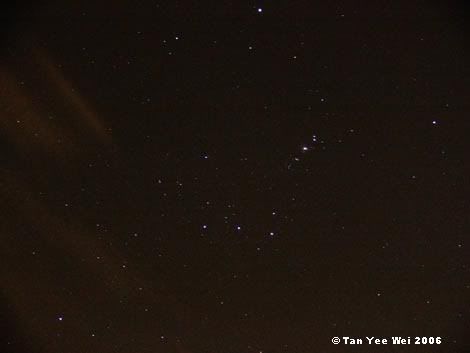Photography of celestial objects

Starz
Click here for large size image
Bad spelling intentional
Panasonic FZ-30, 15s, f/3.2, ASA 400
Taking this photograph was an adventure. I wanted the image brighter to catch the fainter stars that MUST be lurking out there, hence I needed to expose the sensor for a longer duration.
However, because the earth rotates and because I do not have an equatorial mount (as used with astronomy telescopes), the stars will track across the sensor, smearing points into streaks. So I had to keep the exposure time low.
To that end, the aperture and sensor’s sensitivity were maximised. Increasing the ASA number produced a lot of noise, so the in-camera noise reduction was increased from ‘low’ to ‘standard’. The Panasonic sensor is notorious for its horrible noise, and it lived up to its name here.
Much of the noise was manifested in red colour, which made noise removal remarkably simple- using Photoshop, adjust (read: randomly fiddle with) the levels of the ‘red’ channel.
Focusing was another major pain. The FZ30 uses a fly-by-wire manual focus ring that instructs a motor to adjust the focal length. Added to the fact that the focal range goes beyond infinity (it can actually focus converging rays) means that focusing needs to be performed on something bright but still sufficiently far away (like a building over the horizon).
All these can be cured with money:
Mount a Canon EOS 30D (or a hacked 300D) with an EF 50mm f/1.8 lens that has focal distance marks.
Set the sensitivity to ASA 800 (you can actually do it at ASA 3200, but let’s not be too radical)
Set the lens to manual focus, and turn it to infinity.
Set exposure time to 5s.
The resulting photograph would be almost certainly noise-free, properly focused and free of star-trails.
However, because the earth rotates and because I do not have an equatorial mount (as used with astronomy telescopes), the stars will track across the sensor, smearing points into streaks. So I had to keep the exposure time low.
To that end, the aperture and sensor’s sensitivity were maximised. Increasing the ASA number produced a lot of noise, so the in-camera noise reduction was increased from ‘low’ to ‘standard’. The Panasonic sensor is notorious for its horrible noise, and it lived up to its name here.
Much of the noise was manifested in red colour, which made noise removal remarkably simple- using Photoshop, adjust (read: randomly fiddle with) the levels of the ‘red’ channel.
Focusing was another major pain. The FZ30 uses a fly-by-wire manual focus ring that instructs a motor to adjust the focal length. Added to the fact that the focal range goes beyond infinity (it can actually focus converging rays) means that focusing needs to be performed on something bright but still sufficiently far away (like a building over the horizon).
All these can be cured with money:
Mount a Canon EOS 30D (or a hacked 300D) with an EF 50mm f/1.8 lens that has focal distance marks.
Set the sensitivity to ASA 800 (you can actually do it at ASA 3200, but let’s not be too radical)
Set the lens to manual focus, and turn it to infinity.
Set exposure time to 5s.
The resulting photograph would be almost certainly noise-free, properly focused and free of star-trails.
Photographs
Labels: photographic equipment, photography

<< Home